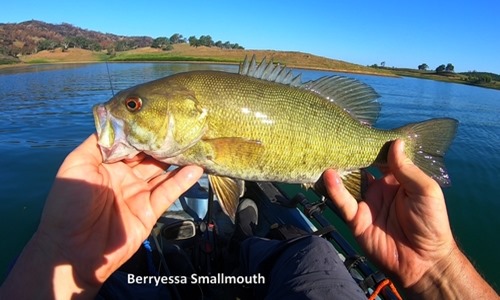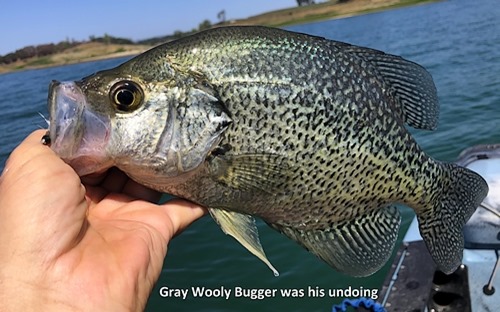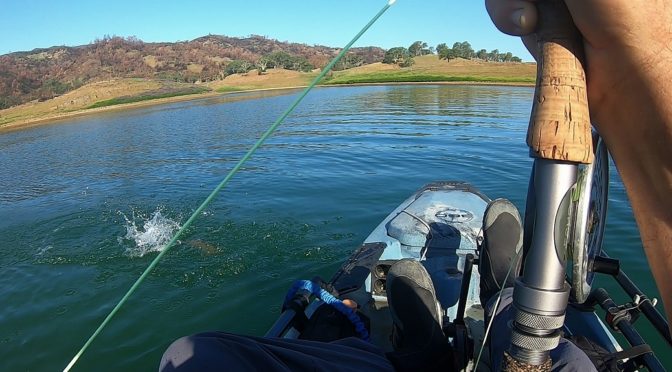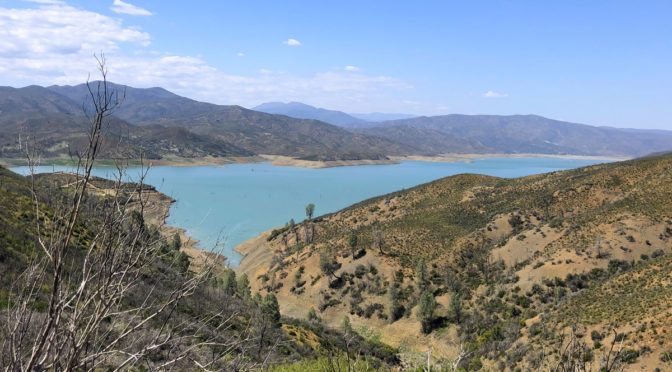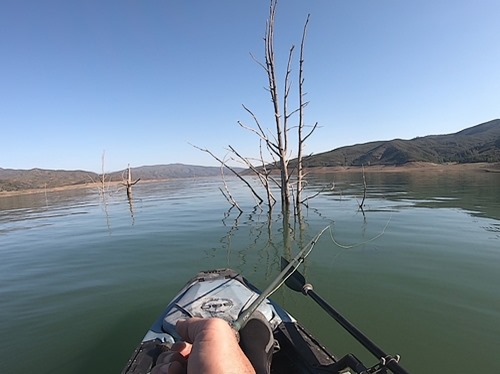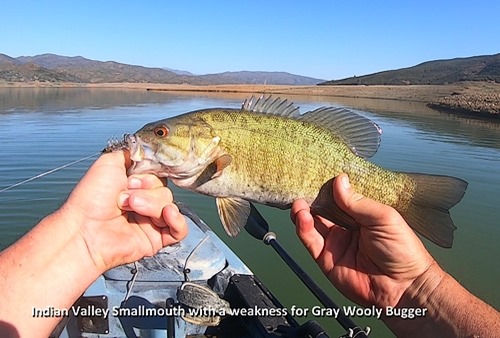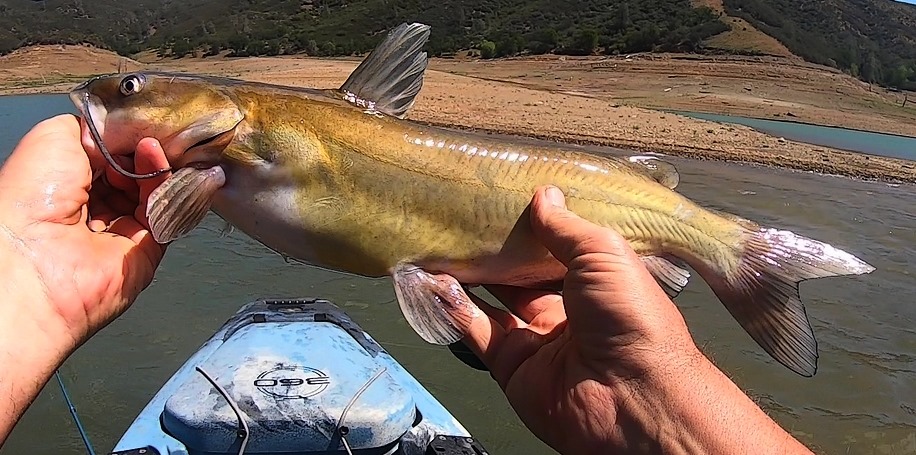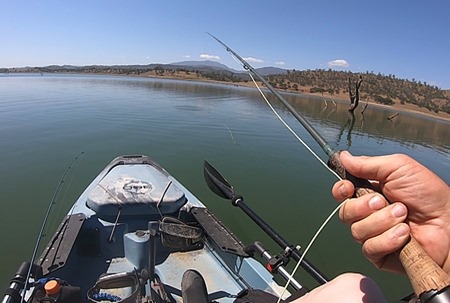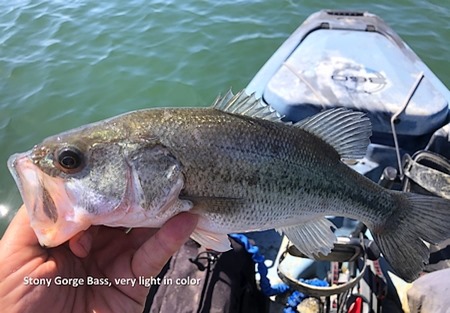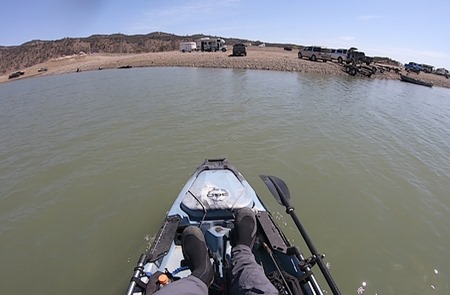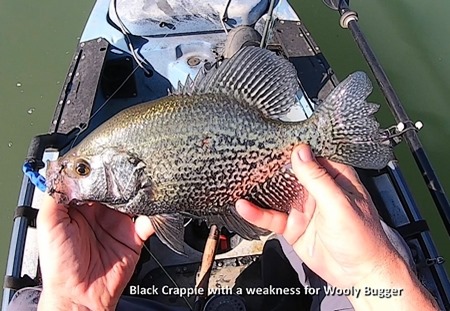Anyone that’s fished for any length of time can channel unflinching optimism, but “too good to be true” is a bubble burst upon us many times. On the outside we’re cocksure and tough, on the inside all that optimism is tempered with reality.
… and now, moments away from losing my first fly in Bass Paradise, having listened to the story of its birth and resurrection, that same inner demon is tugging at my sleeve suggesting, “ … it’s hot out, maybe you should have been here last week.”
Schooled by adversity, I’m not used to flinching in the face of awesomeness.
And it was plenty hot already. As a guest I didn’t set departure and arrival times, and midday temps were scheduled for triple digits, so I eschewed the float tube for the breathable waist-highs (review coming later), and marched out on the first earthen finger …
Bass and Bluegill were visible all around me, and starkness of my pear shaped frame sky-lined against blue sky sent everything living into a panic of flight. Big wakes peeled away into the tules or buried themselves into the neighboring weedy growth, and all I could do was note my “dried tule” camouflage might be hell on geese, but wasn’t fooling fish at all.
With visions of sugarplums dancing in my frontal lobe, I added one of my Massive Protein flies onto the leader. Assuming the fish were measured in yards and therefore only flies representing stray dogs or unattended children would be worthwhile.
Nothing.
I removed the Massive Black Hole of Tungsten off of the leader and opted for the more sedate Eye Searing Crayfish of Rubber-legged Death and flung that at them …
Nothing.
I’m conscious of the retired bass pro snickering to himself as he ties another willow sapling onto a bamboo stake. “ I’ve got to get these up high so the deer don’t eat them,” he says, “You probably want to throw a frog at them.”
He opens the back of his vehicle and on top of the pile of muddy boots, shovels, picks, and rusty chainsaw, are about nine pre-strung spinning rods each rigged with 30lb braid and a variety of baits. Freeing one of them he shows me what “frog” means.
I nod sagely, and produce my Letters of Marque, a fly box stuffed with spun deer hair poppers in a dizzying array of colors. I grab the biggest untrimmed Yellow and Olive, rubber-legged monstrosity and heave that at the fish.
Gurgle … Burble … Bloop. Nothing.
By this time my buddy is in his float tube in mid pond and finning around expectantly, and having similar luck.
The top water bait fails to motivate the fish, so I return to the Crayfish pattern. I’m cinching up the knot when I see a big shadow detach itself form the Tule clump next to me and sidle into a weed channel nearby. I figured Mister Fatty was lying in wait, and flipped the Crayfish out past him and gave it a tug …
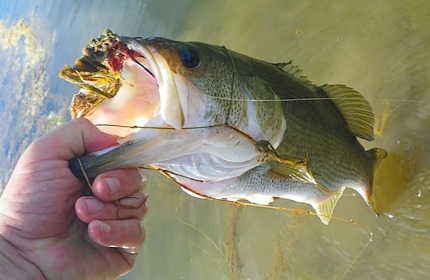
Apparently “Fatty” had the same weakness for hot orange and rubbery as did his cousins up at Lake Berryessa.
I spent the morning touring the lake and trying each of the areas defined by the earthen piers, but fishing was very slow, and I was thinking the drought had upended the feeding timetable a bit, and earlier would have been more appropriate.
As I made a full circle and stopped to compare notes with the proprietor, he offered up a rod and a big Styrofoam cup of earthworms. He motions to me, “let’s go catch some of these big Bluegill” he remarks, “I had a nine year old girl out here yesterday with her folks, and she caught fifty-seven without having to move.”
I grabbed the proffered rod and cowboy’d up. My host was unfamiliar with fly tackle and its efficacy and was doing his best to ensure I had a good time. I dropped that weightless earthworm in amongst the tules and quickly pulled a half dozen panfish out of their den. I handed the rod back and reached for the fly rod and downsized the bait to a trout sized bug and then proceeded to lay waste to the surroundings.
I cracked open the fly box and showed him our variants on panfish delicacies, and how each could be applied with great accuracy – so long as you donated a double-fistful to overhanging branches.
“Them brightly colored ones are a nice accent to your poppies, aren’t they?” I was a little reluctant to tug on his tules for fear of wrenching up all those painstakingly planted stalks. Apparently they are sunk in one pound coffee cans, and spread from that source into a traditional gaggle of plants.
I did have the luxury of catching a few while I had a willing cameraman, and as it’s not often my countenance graces these pages, so this one’s for Ma …
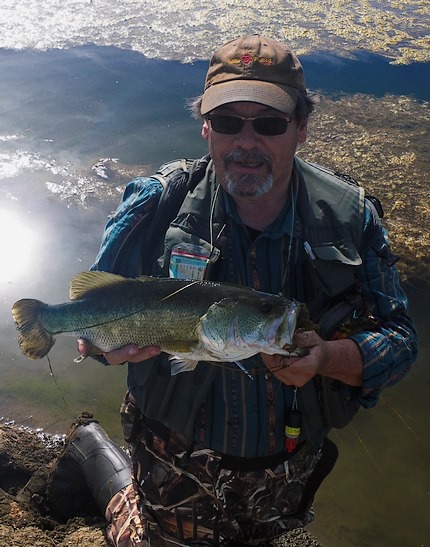
Note the emphasis on grooming and cutting edge angling fashion.
Wading this pond was out of the question. Earthworks lack the integrity of natural substrate, and stepping off the path area meant sinking into mud. The kind of cloying greasy mass that requires you to hold onto your waders for fear of climbing out of them.
By afternoon the temperature was getting to be an issue, and a welcome breeze started blowing that caused everything to get stupid for about two hours.
Screams from the center of the lake suggested my fishing buddy was doing passably well …
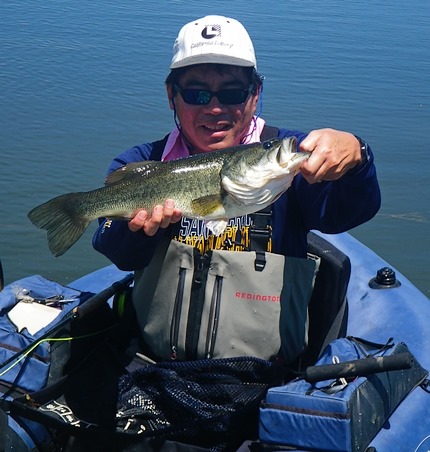
These being some of the largest bass he’d ever caught. Note the skinny abdomen on this slug, it’s a post-spawn bass that likely will weigh considerably more once filled out again.
Most of the fish we caught were recent spawners, given April and May is their traditional spawn time for this part of the foothills, which we confirmed with our host.
Big bluegill dominated most of the afternoon. Once the breeze put a riffle on the water the fish were much more aggressive. Most of these were about the size of your hand, which is prime size for putting a strain into a seven weight.
I did manage to catch one rarity. One of the breed stock of Black Crappy ate my Olive Leech, and while the fish is not rare in California, the builder mentioned he’d only planted a few breeders to see if they’d take root, and they had not been overly successful to date.
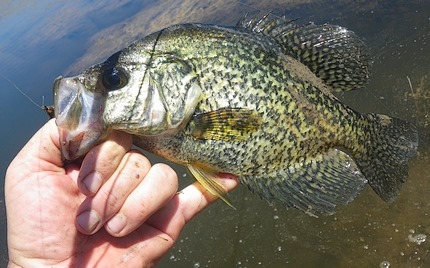
I have always adored these fish – given their swarming numbers and aggression. They are fine table fare and likely will do quite well in all that overly warm, newly empty trout water.
I’d describe the outing as nothing short of fabulous. If we’d gotten there a couple of weeks earlier the weeds would have been a bit less pervasive, and the daytime temperatures more friendly, the bass fatter and more susceptible to being caught due to nesting behavior.
Any water managed for excellence is likely to draw an eager and appreciative crowd. It’s therefore heartening to know that despite inevitable changes to our environment and our quarry, from fragile salmonids to warm water cockroach, we’ll be undaunted … as opinionated and gear oriented as ever.
Technorati Tags:
largemouth bass,
fly fishing for bass,
crappie fishing,
bluegill,
panfish,
managed warmwater,
fishery,
frog pattern,
crayfish fly,
lake berryessa,
tungsten,
nesting,
float tube
